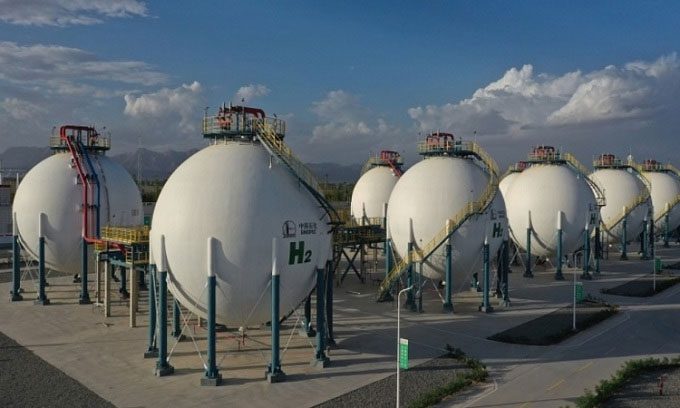Sinopec’s plant in Xinjiang harnesses solar power to produce 10,000 tons of hydrogen per year in its initial phase, with plans to gradually increase production to 20,000 tons annually.
China’s Largest Green Hydrogen Plant, powered by solar energy, commenced operations after the first solar panel was installed in Kuerle, Xinjiang Uyghur Autonomous Region, on August 30. The facility can produce hydrogen without carbon emissions, replacing the older method that relies on natural gas, according to CGTN.

Hydrogen storage sphere at the plant in Kuerle. (Photo: CFP).
The new green hydrogen facility is expected to reduce carbon dioxide emissions by 485,000 tons annually, marking a significant breakthrough in China’s efforts to cut emissions. The solar panel field spans an area equivalent to 900 football fields at the plant. Thanks to the local climate providing abundant solar energy, the plant can generate nearly 600 million kilowatt-hours of electricity each year.
Both the front and back sides of the solar panels can absorb sunlight and generate electricity, enhancing the total electricity output by 3 to 5%. The electrolyzers, a crucial component in hydrogen production, have been upgraded to save space and reduce costs. The project utilizes 52 high-efficiency electrolyzers. Technicians have developed a self-sustaining system to ensure a stable solar power supply for hydrogen production.
As the only petrochemical company of the Sinopec group in Xinjiang, Tahe Company supplies approximately 70% of the petroleum in southern Xinjiang. However, the hydrogen used in the current oil refining process emits significant amounts of carbon dioxide. Transitioning from natural gas-based hydrogen production to solar power will play a vital role in reducing emissions.
“Two natural gas-based hydrogen production facilities will be shut down, saving 24,000 tons of natural gas. The next step is to enhance solar-powered hydrogen production,” emphasized Liu Ziying, Deputy Director of Production Management at Tahe Company. The shift in the chemical industry is crucial for achieving carbon neutrality. Carbon emissions from the chemical industry nationwide account for about 20% of China’s industrial emissions.




















































